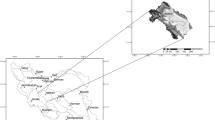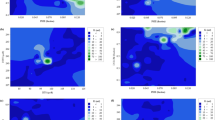Abstract
Water saturation is a key parameter in reservoir engineering to calculate the volume of hydrocarbon in reservoirs. The first attempt to estimate water saturation using well log data was implemented by Archie in 1942 for a clean sandstone reservoir. This method requires laboratory measurement of cementation factor. This parameter has the most impression on water saturation calculation compared to the other parameters, which is nearly constant in homogenous sandstone reservoirs. However, due to high variation of cementation factor along depth of wellbore in carbonate reservoirs due to rock’s nature, it is incorrect to assign a constant value to cementation factor. On the other hand, experimental core analysis to determine cementation factor values is an expensive and time-consuming work, and it is impossible to calculate this parameter in laboratory for the whole depth of a drilled wellbore. In industrial applications, using a constant cementation factor can lead to erroneous calculations of water (and hence oil) saturations. Also, previous conventional methods estimating cementation factor from logging data are not often sensitive to pore system of rock and generate a massive source of error. In this study, a new approach to estimate cementation factor using a genetic Mamdani fuzzy inference system was implemented for a case study in Sarvak Formation located in Zagros Basin which is mostly composed of pure limestone. The final results show a high exactness of the proposed model estimating cementation factor with an R-squared of 0.864 and a mean squared error of 0.01899 .




Similar content being viewed by others
Abbreviations
- m :
-
Cementation factor
- φ :
-
Porosity
- a :
-
Tortuosity factor
- n :
-
Stauration exponent
- FIS:
-
Fuzzy inference system
- FRF:
-
Formation resistivity factor
- R 2 :
-
R-squared
- MSE:
-
Mean square error
- k :
-
Permeability
- MF:
-
Membership function
- c :
-
Center of Gaussian and sigmoidal membership function
- σ :
-
Width of Gaussian membership function
- α :
-
Parameter of sigmoid membership function
- GA:
-
Genetic algorithm
- MD:
-
Membership degree
- FMI:
-
Formation micro imager
- NMR:
-
Nuclear magnetic resonance
References
Archie GE (1942) The electrical resistivity log as an aid in determining some reservoir characteristics. Trans AIME 146:54–67
Winsauer WO, Shearin HM, Masson PH, Williams M (1952) Resistivity of brine saturated sands in relation to pore geometry. Am Assoc Pet Geol Bull 36:253–277
Ransom RC (1984) A contribution toward a better understanding of the modified Archie formation resistivity factor relationship. Log Anal 2:7–12
Salem HS, Chilingarian GV (1990) The cementation factor of Archie’s equations for shaly sandstone reservoirs. J Pet Sci Eng 23:83–93
Doveton JH (2014) Principle of mathematical petrophysics. International Association for Mathematical Geoscience, Oxford University Press, Oxford
Hamada GM, Almajed AA, Okasha TM, Alghate AA (2013) Uncertainty of Archie’s parameters determination techniques in carbonate reservoirs. J Pet Explor Prod Technol 3:1–10
Salazar JM, Wang GL, Verdin CT, Lee HJ (2007) Combined simulation and inversion of SP and resistivity logs for the estimation of connate water resistivity and Archie’s cementation exponent. In: SPWLA, Austin, TX
Schlumberger: log interpretation charts 15. Huston (1984)
Borai AM (1987) A new correlation for the cementation factor in low-porosity carbonates. SPE Form Eval 2(4):495–499
Sethi DK (1979) Some considerations about the formation consideration resistivity factor-porosity relations. In: SPWLA, 20th annual logging symposium
Towel G (1962) An analysis of the formation resistivity factor-porosity relationship of some assumed pore geometries. In: SPWLA 3rd annual logging symposium
Focke JW, Munn D (1987) Cementation exponent in Middle Eastern carbonate reservoirs. SPE Paper No. 13737, SPE formation evaluation, June, a55–167
Gomez-Rivero O (1977) Some consideration about the possible use of the parameters a and m as a formation evaluation tool through well logs. In: SPWLA 18th annual logging symposium
Cuddy SJ, Glover PWJ (2002) The application of fuzzy logic and genetic algorithms to reservoir characterization and modeling. Fuzziness Soft Comput 80:219–241
Potter DK et al (2003) Genetic petrophysics approach to core analysis-application to shoreface sandstone reservoirs. In: International symposium of the society of core analysts, SCA2005-37. Pau, France
Le AH, Potter DK (2003) Generally focused neural nets for permeability prediction from wireline logs. In: 65th conference of European association of geoscience and engineers. Stavanger, Norway
Cordon S, Herrera F, Hoffmann F, Magdalena L (2001) Genetic fuzzy systems evaluation tuning and learning of fuzzy knowledge bases. World Scientific Publishing Co, Pte, Ltd, Hackensack
Zadeh LA (1973) Outline of a new approach to the analysis of complex systems and decision processes. IEEE Trans Syst Man Cybern 3:28–44
Matlab User’s Guide (2007) Fuzzy logic toolbox user’s guide Matlab CD-ROM. MathWorks Inc, Natick
Holland JH (1975) Adaptation in natural and artificial system. University of Michigan Press, Ann Arbor, p 183
Farag WA, Quintana VH, Lambert-Torres G (1998) A genetic-based Neuro-Fuzzy approach for modeling and control of dynamical systems. IEEE Trans Neural Netw 9(b):756–767
Lucia FJ (1983) Petrophysical parameters estimated from visual descriptions of carbonate rocks: a field classification of carbonate pore space. J Pet Technol 35:629–638
Homaifar A, McCormick E (1995) Simultaneous design of membership functions and rule sets for fuzzy controller using genetic algorithm. IEEE Trans Fuzzy Syst 3(2):129–139
Marsh S, Huang YW, Sibigtroth J (1994) Center of emerging compute technologies, Motorola. Fuzzy Logic Program 2.0
Miller BL (1995) Genetic algorithm, tournament selection, and the effect of noise. Complex Syst 9:193–212
Sywerda G (1989) Uniform crossover in genetic algorithms. In: Proceedings of the 3rd international conference on genetic algorithm, USA, pp 2–9
Leung FHF, Lam HK, Ling SH, Tam PKS (2003) Tuning of the structure and parameters of a neural network using an improved genetic algorithm. IEEE Trans Neural Netw 14:79–88
Masoudi P, Tokhmechi B, Bashari A, Jafari MA (2012) Identification productive zones of the Sarvak formation by integrating outputs of different classification methods. J Geophys Eng 9:282–290
Coates GR, Xiao L, Prammer MG (1999) NMR logging, principle and applications. Halliburton Energy Services Publication Inc., Huston, pp 64–66
Shafer JL, Chen S, Georgi DT (2005) Protocols for calibrating NMR log-derived permeabilities. In: International symposium of the society of core analysts, SCA2005-37
Allen D et al (2000) Trends in NMR logging. Oilfield Rev 12:2–19
Delhomme JP (2007) The quest for permeability evaluation in wireline logging. Oilfield Rev 8(1):10–12
Serra O (1989) Formation micro scanner image interpretation. Schlumberger Educational Services, Houston, pp 80–83
Sullivan KB, Schepel KJ (1995) Borehole image logs: applications in fractured and thinly bedded reservoirs. In: SPWLA 36th annual logging symposium
Albert BY, Frohne KH, Komar CA, Ameri S (1982) Techniques to determine natural and induced fracture relationships in Devonian shale. J Pet Technol 34:1371–1377
Hornby BE, Luthi SM (1992) An integrated interpretation of fracture apertures computed from electrical borehole scans and reflected Stoneley waves. Geological application of wireline logs II. Geol Soc Spec Appl 65:185–198
Author information
Authors and Affiliations
Corresponding author
Rights and permissions
About this article
Cite this article
Heydari Gholanlo, H., Hajipour, Z. Estimation of cementation factor in carbonate reservoir by using genetic fuzzy inference system. Neural Comput & Applic 30, 1657–1666 (2018). https://doi.org/10.1007/s00521-016-2770-1
Received:
Accepted:
Published:
Issue Date:
DOI: https://doi.org/10.1007/s00521-016-2770-1




